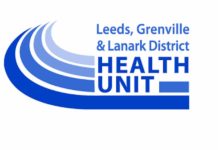Starting Friday, January 14, 2022, the Leeds, Grenville and Lanark District Health Unit has been posting an updated COVID-19 Dashboard, in response to recent changes in COVID-19 testing eligibility.
As announced in late December, the Ontario government has made significant changes to the eligibility for publicly funded Polymerase Chain Reaction (PCR) testing, in order to ensure testing is available for individuals who work in, or attend, highest risk settings. Publicly funded PCR testing is now limited to symptomatic high-risk individuals, and individuals who work in high-risk settings. This change came into effect on December 31, 2021, and, as a result, positive cases confirmed by PCR testing will underestimate the true number of individuals with COVID-19 in the community. To address this, many local public health agencies are changing how COVID-19 cases are reported in their regions.
The new LGL dashboard will include:
- Daily New Lab-Confirmed COVID-19 Cases (limited to eligible people for PCR testing);
- Trends for Daily New Lab-Confirmed COVID-19 Cases by Date;
- Trends for New Lab-Confirmed COVID-19 Hospitalizations by Date;
- Trends for Respiratory-Related Emergency Department Visit Counts;
- Outbreaks in high-risk settings such as long-term care homes, retirement homes, hospitals, and congregate living settings – the weekly outbreak report will be discontinued and archived; and
- COVID-19 Viral Material Detected in Municipal Wastewater. Wastewater surveillance for COVID-19 involves testing for the presence of viral gene fragments that are shed by both asymptomatic and symptomatic individuals into municipal wastewater systems. Monitoring wastewater for COVID-19 can be used as a tool for surveillance, alongside other public health indicators, to identify COVID-19 trends in the region and support mobilization of resources related to the COVID-19 response.
The discontinued sections include:
- Variants of Concern (as Omicron is the dominant variant, and only a small number of PCR tests will be screened for Omicron);
- Cases by age, source of acquisition, and geography (map with sub-regions), as high-risk cases only represent a small segment of the population and they are not community based; and
- Cases per 100,000 population as case rates no longer reflect the true rate of COVID-19 in the whole population.
The COVID-19 Surveillance Dashboard will now be updated each week on Monday, Wednesday and Friday at 10am (not statutory holidays).
The Surveillance Report and Weekly Vaccination Report will continue to be found here: https://healthunit.org/health-information/covid-19/local-cases-and-statistics. Archived data will be available on the site; there is differentiation between data from before and after the change in testing eligibility on all existing graphs for testing and cases over time, as the time periods are not comparable.
Although daily COVID-19 case counts are no longer representative of COVID-19 activity in our local area, we know there is widespread COVID-19 community activity across Ontario, and we know the risk of transmission is high. This means it is important for everyone to continue following COVID-19 precautions, such as vaccination, wearing a mask, and reducing social contacts. There are also Frequently Asked Questions available to help further explain what the changes mean to you if you were following the report every day.
More information is available on recommendations for PCR testing and the eligible groups. All residents are reminded that testing is not needed to know what to do if you have symptoms of COVID-19. ALL individuals with symptoms of the virus MUST isolate for a minimum of 5 days, even if you are not eligible for a PCR test.
For the most up to date information on COVID-19, visit www.healthunit.org/coronavirus, or www.Ontario.ca/coronavirus.







